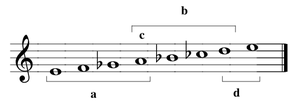Pyknon
Pyknon (from
Definition
The pyknon was an important criterion in the classification of melodic genera (
Theoretical applications
The notes of the central tetrachord of the system in ascending order are hypate, parhypate, lichanos (or hypermese), and mese. A second tetrachord is added above, after a disjunctive tone, and the corresponding names (together with the interval ratios of the standing tones) are:[6]
- mese (4:3) – nete (2:1) (standing)
- lichanos – paranete (movable)
- parhypate – trite (movable)
- hypate (1:1) – paramese (3:2) (standing)
Although movable, the lichanos must remain above the parhypate, and the paranete above the trite.[7]
A "composite interval" is one made up of two or more smaller intervals; an "incomposite interval" has no smaller components In these terms, if the composite interval between the hypate and the lichanos (or paramese and paranete) is smaller than the incomposite interval from the lichanos to the mese (or paranete to nete), the three notes in that composite interval are together called a pyknon.[7] In the diatonic genus, because the composite interval from hypate to lichanos (a minor third) is larger than the remaining incomposite interval from lichanos to mese (a whole tone), the lowest three notes of the diatonic tetrachord are designated apyknon: "not close-packed".[8]
Enharmonic

In the enharmonic genus, the large incomposite interval was originally a
Chromatic

In the chromatic genus, the largest interval was called a
Scale structure

A further refinement of tetrachordal construction, according to Aristoxenus, is that the lower interval of the pyknon must be smaller than or equal to the upper one.[20] Didymus in the chromatic genus and Archytas in the enharmonic broke this rule, however, and in the Harmonics (2. 13) Ptolemy criticized this feature in Didymus, holding that it is unmelodic and out of agreement with the evidence of our ears.[13]
According to Aristoxenus' Elementa harmonica (Elements of Harmony, book 2), whenever tetrachords are combined to form a scale filling an octave, "Two consecutive pycna may not occur in ascent or descent. A ditone may precede or follow [a pycnon] in ascent or descent. A tone may follow [a pycnon] only in descent".[21]
References
- Barbera, André (1977). "Arithmetic and Geometric Divisions of the Tetrachord". Journal of Music Theory. 21 (2 - Autumn): 294–323. JSTOR 843492.
- Barbera, André (1984). "Octave Species". The Journal of Musicology. 3 (3 - Summer): 229–241. JSTOR 763813.
- Barker, Andrew (1981). "Methods and Aims in the Euclidean Sectio Canonis". Journal of Hellenic Studies. 101: 1–16. S2CID 162356270.
- Chalmers, John (1990). Larry Polansky; Carter Scholz (eds.). Divisions of the Tetrachord. Lebanon NH: Frog Peak Music. ISBN 0-945996-04-7.
- S2CID 151484983.
- Mathiesen, Thomas J. (1999). Apollo's Lyre: Greek Music and Music Theory in Antiquity and the Middle Ages. ISBN 9780803230798.
- Solomon, Jon (1984). "Towards a History of Tonoi". The Journal of Musicology. 3 (3 - Summer): 242–251. JSTOR 763814.
Footnotes
- ISBN 0-19-864226-1.
- ^ Levin 2007, p. 413.
- ^ Mathiesen 1999, pp. 301, 312, 322, 344, 350, et passim; from Greek: κινούμενοι φθόγγοι.
- ^ Barbera 1984, p. 229.
- ^ Solomon 1984, p. 246.
- ^ Chalmers 1990, p. 4; Mathiesen 1999, p. 245.
- ^ a b Mathiesen 1999, p. 312.
- ^ Barbera 1977, p. 321n11.
- ^ a b Chalmers 1990, p. 9.
- ^ a b Chalmers 1990, p. 8.
- ^ Mathiesen 1999, p. 333.
- ^ Barker 1981, p. 6.
- ^ ISBN 0585229929(electronic bk.).
- ^ Chalmers 1990, pp. 7–8.
- ^ Bower, Calvin (1989). Fundamentals of Music. Anicius Manlius Severinus Boethius. Translated, with Introduction and Notes by Calvin M. Bower. New Haven and London: Yale University Press. p. 43.
- ISBN 9780521517645.
- ^ Levin, Flora R. (1994). The Manual of Harmonics of Nicomachus the Pythagorean. Translation and commentary by Flora R. Levin. Grand Rapids MI: Phanes Press. pp. 125, 174.
- ^ Barker, Andrew (1989). Greek Musical Writings. Vol. II: Harmonic and Acoustic Theory. Cambridge University Press. pp. 261, 267.
- ^ Strunk, Oliver. 1998. Source Readings in Music History. Revised Edition by Leo Treitler. New York City, London: W. W. Norton and Company. pp. 36-7.
- ^ Barbera 1984, pp. 229–30.
- ^ Mathiesen 1999, p. 331.
Further reading
- Mathiesen Thomas J. 2001. "Greece, §I: Ancient", The New Grove Dictionary of Music and Musicians, second edition, edited by Stanley Sadie and John Tyrrell. London: Macmillan Publishers.
- Winnington-Ingram, Reginald Pepys. 1936. Mode in Ancient Greek Music. Cambridge Classical Studies 2. Cambridge: The University Press. Reprinted, Chicago, Argonaut Inc., 1967; Amsterdam: Adolf M. Hakkert, 1968.
